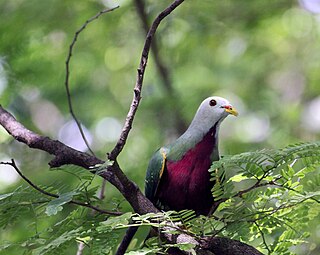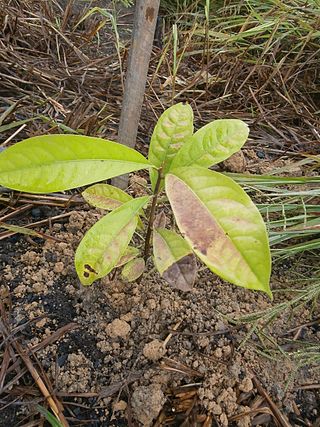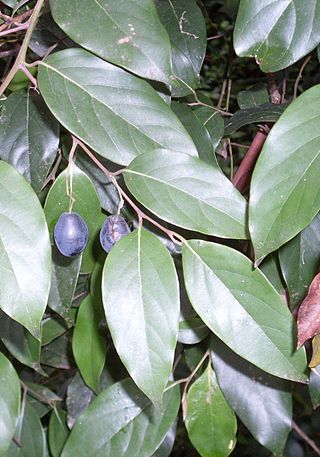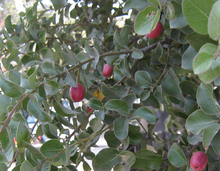
Lauraceae, or the laurels, is a plant family that includes the true laurel and its closest relatives. This family comprises about 2850 known species in about 45 genera worldwide. They are dicotyledons, and occur mainly in warm temperate and tropical regions, especially Southeast Asia and South America. Many are aromatic evergreen trees or shrubs, but some, such as Sassafras, are deciduous, or include both deciduous and evergreen trees and shrubs, especially in tropical and temperate climates. The genus Cassytha is unique in the Lauraceae in that its members are parasitic vines. Most laurels are highly poisonous.

Eucryphia is a small genus of trees and large shrubs native to the south temperate regions of South America and coastal eastern Australia, mainly Tasmania. Sometimes placed in a family of their own, the Eucryphiaceae, more recent classifications place them in the Cunoniaceae. There are seven species, two in South America and five in Australia, and several named hybrids.

Persea is a genus of about 150 species of evergreen trees belonging to the laurel family, Lauraceae. The best-known member of the genus is the avocado, P. americana, widely cultivated in subtropical regions for its large, edible fruit.

Endiandra is a genus of about 126 species of plants, mainly trees, in the laurel family Lauraceae. They are commonly called "walnut" despite not being related to the Northern Hemisphere walnuts which are in the family Juglandaceae.

The wompoo fruit dove, also known as wompoo pigeon and "magnificent fruit dove" among others, is one of the larger fruit doves native to New Guinea and eastern Australia.

Neolitsea dealbata, also known as white bolly gum, hairy-leaved bolly gum, or simply bolly gum, is a shrub or small tree in the laurel family Lauraceae which is native to New South Wales and Queensland in Australia.

Aniba is an American neotropical flowering plant genus in the family Lauraceae. They are present in low and mountain cloud forest in Caribbean islands, Central America, and northern to central South America.

Beilschmiedia is a genus of trees and shrubs in family Lauraceae. Most of its species grow in tropical climates, but a few of them are native to temperate regions, and they are widespread in tropical Asia, Africa, Madagascar, Australia, New Zealand, North America, Central America, the Caribbean, and South America. The best-known species to gardeners in temperate areas are B. berteroana and B. miersii because of their frost tolerance. Seeds of B. bancroftii were used as a source of food by Australian Aborigines. Timbers of some species are very valuable.

Cryptocarya alba, the peumo or Chilean acorn, is an evergreen tree that grows in Chile and Argentina from 33 to 40° southern latitude. It can live both in wet and as in dry conditions. Its distribution can reach up to 1500 meters (5000 ft) above sea level. It measures up to 20 meters (65 ft) height and one meter diameter, with cracked gray bark. An associate tree is the endangered Chilean Wine Palm, Jubaea chilensis, which species prehistorically had a much wider range.

The native flora of Chile is characterized by a higher degree of endemism and relatively fewer species compared to the flora of other countries of South America. A classification of this flora necessitates its division into at least three general zones: the desert provinces of the north, Central Chile, and the humid regions of the south.

Cryptocarya erythroxylon is a medium to large rainforest tree, that grows from the Barrington Tops in New South Wales to the Gladstone area in Queensland. The common name is the pigeonberry ash, rose maple, or rose walnut.

Cryptocarya microneura is a rainforest tree growing at the eastern coastal parts of Australia.

Cryptocarya rigida is a small tree or shrub growing in high rainfall areas in north eastern New South Wales, Australia. It was described in 1864 by Carl Meissner in Prodromus Systematis Naturalis Regni Vegetabilis. Extinct in the Illawarra region, allegedly seen in the Illawarra in 1818 by Allan Cunningham.

Cryptocarya triplinervis is a rainforest tree growing in eastern Australia. Common names include the three veined laurel, three veined cryptocarya and the brown laurel.

Cryptocarya bidwillii, the yellow laurel, is a small to medium-sized tree in the laurel family. Occurring in Australian rainforests from Nymboida in the state of New South Wales to Townsville in tropical Queensland. Often found in the dryer ridges in dry rainforest or in viney scrubs.
Cryptocarya caesia is a tree in the family Lauraceae reported from Java Island in Indonesia and the Andaman Islands in the Bay of Bengal. This species was originally described by Blume from Java in 1851. Later, in 1884, George King located this tree in Port Blair in the Andaman Islands and collected some herbarium specimens.

Cryptocarya corrugata is a species of tree in the family Lauraceae. Found in tropical rainforest in Queensland in Australia, this species may grow to 35 metres tall. It was collected by William Francis west of Mackay in the Eungella range in 1922. The fruit is eaten by cassowaries and fruit pigeons.

Cryptocarya anamalayana is a rare rainforest tree endemic to the southern Western Ghats, India. The specific epithet of the name refers to the Anamalai Hills, a major area of its distribution. The species considered endangered under the IUCN Red List of Threatened Species.



















